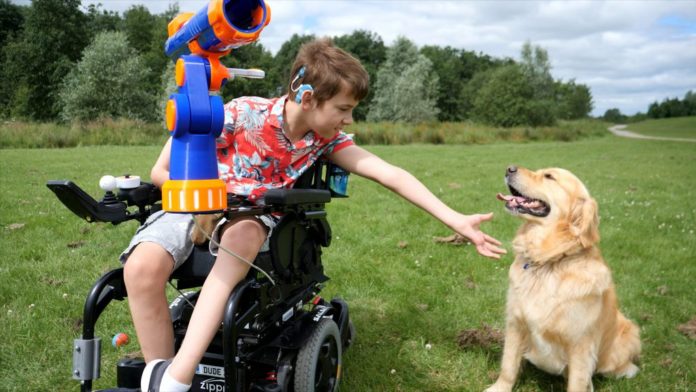Cerebra, an organization health and social care information for the parents and carers of children with a brain condition, recently fabricated a 3D Printed tennis ball shooter for a boy that suffers from cerebral palsy.
Cerebra integrates an innovation centre in-house that develops customized products for children that have a brain condition. Depending on the innovation, the centre often works in collaboration with various centres of the country. This time, the product designers collaborated with ATiC – the University’s integrated research centre –.
Harry Flynn is a young boy of 11 who has Athetoid Cerebral Palsy. In other terms, he has weak motor skills and relies on his wheelchair just to get around. Despite his daily challenges, the young boy remains a busy man with several activities: music, cinema…However, since with the arrival of his dog, Addi into his life, Harry’s life has become even better.
“He helps Harry by doing things like opening doors, opening drawers, turning light switches on and helping to remove socks and coats,” said Harry’s mum Hilary. “Most importantly he’s a constant friend and he encourages him to go outside, which, prior to having Addi, he never liked doing.
“Harry so wanted to play fetch with Addi, who just loves to run after a ball. Sadly, though, Harry doesn’t have the strength or coordination to be able to throw. He loved being outside with Addi but you could see the disappointment on his face each time we went for a walk.”
That’s exactly where the innovation centre comes into play. The team of product designers developed the tennis ball shooter for Harry.
They designed a bracket that could support the launcher while being fixed on Harry’s wheelchair frame. However, the launcher’s firing mechanism had to be altered, so that all Harry had to do was lightly press it to release the ball. They took a Nerf tennis shooter as their starting point and adapted it with 3D printed parts. Dr Ross Head of Cerebra Innovation Centre explains the whole process: “All Harry wants to be able to do is reciprocate and the only way he can do that is to throw a ball for his dog – but he doesn’t have the strength,” he said. “We were able to work with ATiC to get some really cool 3D printing done and create pieces that mean Harry doesn’t need dexterity to be able to pull a trigger.”
From now on, Harry can fire the launcher with no problem. He can now move his wheelchair when he wants. The team of makers integrated joystick controls into his wheelchair so that Harry can easily control the launcher. The young boy can now play with Addi, that supports him every single day of his life.
You can now post free of charge job opportunities in the AM Industry on 3D ADEPT Media.For further information about 3D Printing, follow us on our social networks and subscribe to our newsletter : Facebook, Twitter, LinkedIn & Instagram !Would you like to be featured in the next issue of our digital magazine? Send us an email at contact@3dadept.com






